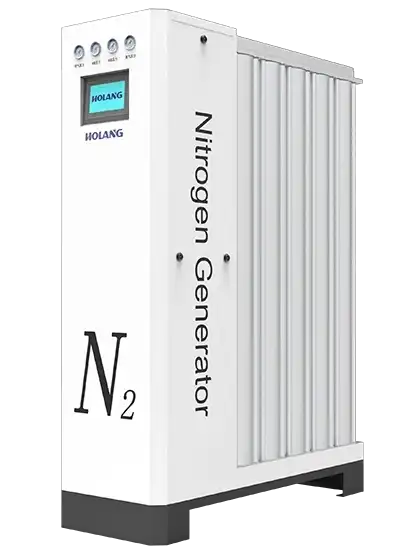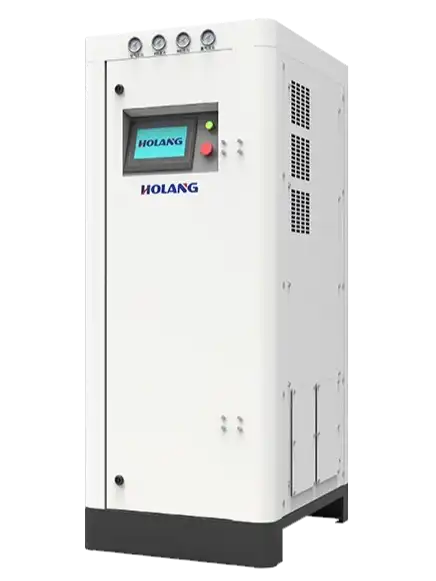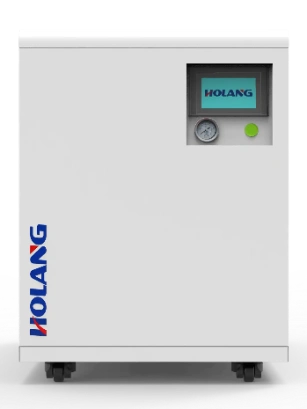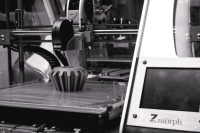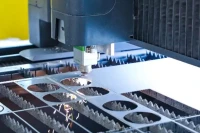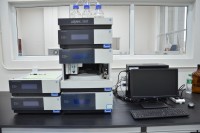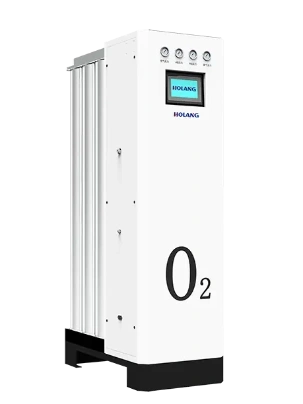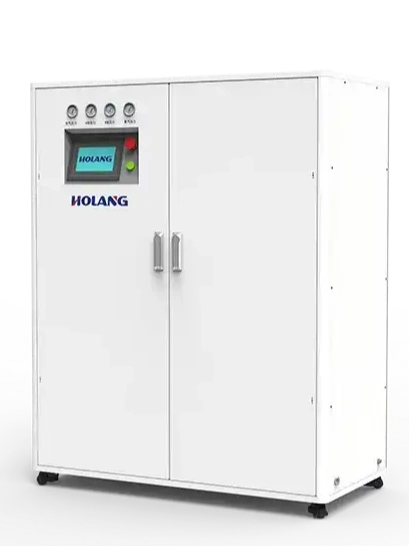The idea behind a Nitrogen Generator is not complicated: compress air, separate oxygen and nitrogen, and deliver nitrogen gas at the required purity. What looks like a simple process hides a critical detail. The jump from 95% nitrogen purity to 99.999% depends on the small black particles packed inside the adsorption towers—Carbon Molecular Sieve (CMS).
These pellets, smaller than a grain of rice, are the true core of the generator. They decide whether the machine can run for years while producing steady, high-purity nitrogen.
.-rfBH0xEq.png)
1. How Carbon Molecular Sieve Works
Carbon Molecular Sieve is a carbon-based material filled with tiny pores. These pores measure only 0.3–0.5 nanometers across and are very uniform. The separation effect comes from differences in molecular size and speed:
- Oxygen molecules (0.298 nm) are smaller and move faster. They slip into the pores quickly and get trapped.
- Nitrogen molecules (0.364 nm) are larger. They move more slowly, so they remain outside and are collected as nitrogen gas.
A PSA (Pressure Swing Adsorption) Nitrogen Generator uses two towers filled with CMS. While one tower adsorbs oxygen under pressure, the other releases oxygen at lower pressure and gets ready for the next cycle. By switching back and forth, the system produces nitrogen continuously.
📌 Key point: without high-quality CMS, the PSA process cannot reach ultra-high purity levels like 99.999%.
2. How CMS Is Made and Why Quality Varies
Raw materials and process
Manufacturers use coal-based or coconut-shell carbon. They process it with heat and chemicals to shape pores of the right size.
Performance measures
- Capacity: how much oxygen the sieve can hold.
- Selectivity: the clearer the difference between oxygen and nitrogen speeds, the higher the purity.
- Strength: strong pellets resist breaking and dusting under pressure.
Market differences
- Local CMS: cheaper, good for standard industrial needs.
- Imported CMS: more stable, preferred for electronics, medicine, and other industries where purity is critical.
3. CMS in the Nitrogen Generator System
The performance of CMS depends on more than material quality. Proper system design matters:
- Packing density: too loose causes air shortcuts; too tight increases energy use.
- Flow plates: spread air evenly through the bed.
- Protective layers: quartz sand or ceramic balls shield CMS from fast airflow.
- Vibration loading: ensures the bed stays firm and avoids sinking during years of use.
Small design choices like these decide whether the CMS lasts ten years or fails in just a few.
4. What Shortens the Life of CMS
- Moisture: water blocks pores forever.
- Fix: use a dryer with a dew point of -40 °C or lower.
- Oil vapor: oil coats pores and poisons the material.
- Fix: use oil-free compressors and multi-stage oil filters.
- Dust: particles clog passages and raise pressure drop.
- Fix: change pre-filters on time.
- Operating stress: frequent start-stops or very high pressure crush the pellets.
- Fix: balance cycles with buffer tanks and steady settings.
📌 With good pretreatment, CMS lasts 8–10 years. Without it, the same material may fail in 2–3 years.
5. Why CMS Defines the Purity Limit
- Standard CMS: delivers 95%–99.5% nitrogen, fine for general metal use.
- High-grade CMS: delivers 99.9%–99.999%, required for electronics, medicine, and battery materials.
The same Nitrogen Generator can perform at very different levels depending on the CMS inside.
⚠️ Common issue: some low-cost machines claim high purity but use low-grade CMS, making real performance far below the label.
6. Where High Purity Really Matters
- Electronics: soldering requires pure nitrogen to stop oxidation.
- Medicine: vaccines and drugs need nitrogen sealing at 99.999% to stay stable.
- Food packaging: coffee beans, nuts, and chips last longer with high-purity nitrogen.
- Laser cutting: cutting thick plates needs pure nitrogen; low purity causes burns and slag.
- Energy storage: battery materials and electrolytes are extremely oxygen-sensitive and demand ultra-high-purity nitrogen.
7. Common Buying Mistakes
- Focusing only on price: ignoring CMS grade often leads to poor results.
- Skipping air treatment: moisture and oil shorten CMS life drastically.
- Not planning lifespan: waiting until purity drops causes costly process failures.
✅ The smart move: pick a manufacturer that offers full systems, including compressors, dryers, filters, and CMS matched together.
8. Best Practices for Maintenance
- Test nitrogen purity often; treat swings as an early warning.
- Replace filters on schedule to block water and oil.
- Watch pressure drop; a rise means CMS may be aging.
- Use operating data to predict CMS life and plan replacement early.
9. Looking Ahead: Smarter and Greener
- Smart control: modern systems track purity, dew point, and power in real time, predicting CMS life.
- Better materials: new CMS types promise higher selectivity, longer service, and lower energy use.
- Green solutions: pairing on-site Nitrogen Generators with renewable power to cut carbon footprints.
Conclusion: Small Pellets, Big Value
Carbon Molecular Sieve may be small, but it is the backbone of modern Nitrogen Generators. From electronics to food to new energy batteries, CMS quietly protects quality and safety by ensuring nitrogen gas stays pure.
Recommended Product | HOLANG Modular Nitrogen Generator – NPL Series
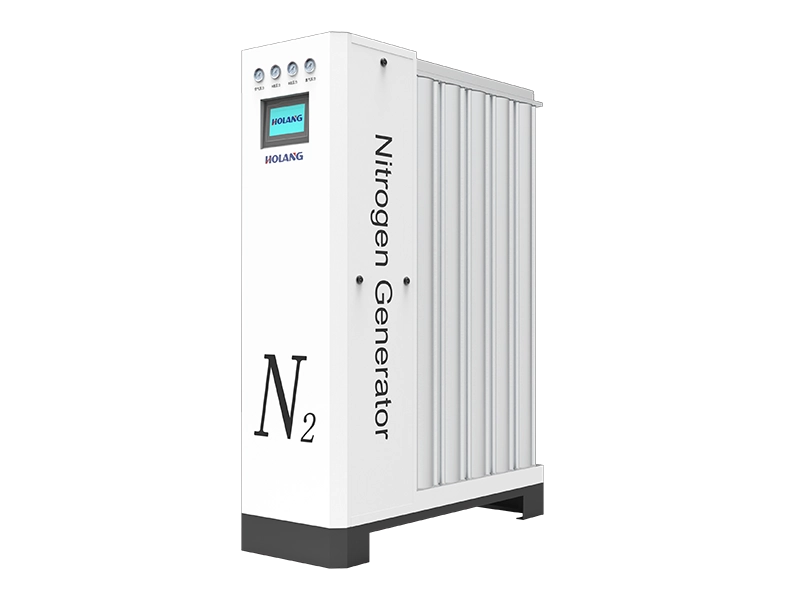
For companies that want a full solution—from Air Compressor to Nitrogen Generator—HOLANG’s NPL Series offers:
- Modular design: units in parallel for backup and expansion.
- High purity: adjustable from 99.9% to 99.999%.
- Energy efficiency: optimized for use with variable-speed compressors.
- Wide use: trusted in electronics, food, laser cutting, and medical fields.
